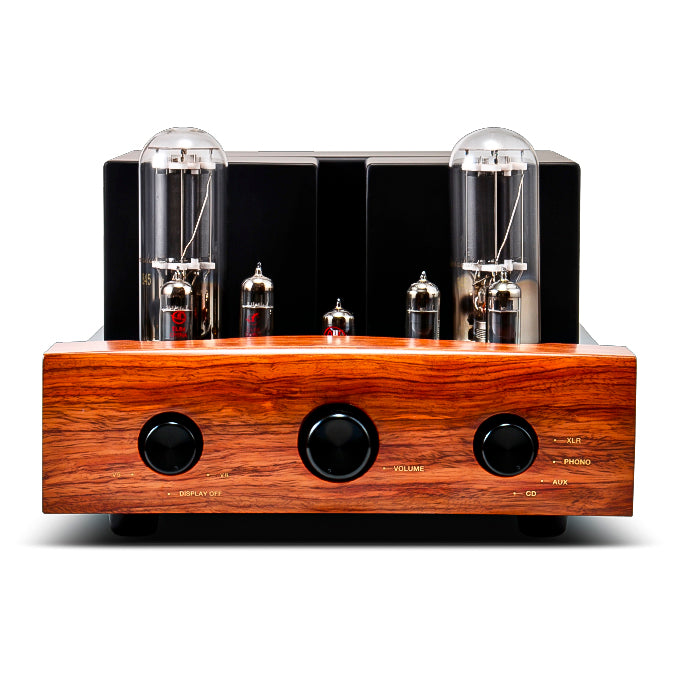Some of you who enjoy listening to music may be considering a vacuum tube amplifier as a choice for enjoying higher quality music in the future, but what are vacuum tubes really? However, there are some people who have questions and concerns about tube amps, such as, "What is actually a tube? This time, I wrote about such after-maintenance of vacuum tubes.
Click here for the product page of vacuum tube amplifiers
https://www.exclusive-audio.jp/shop/products/list.php?category_id=32
Click here for the product page of the amplifier in the photo
https://www.exclusive-audio.jp/shop/products/detail.php?product_id=628
Vacuum tubes are light bulb-like components that have been used for decades before the invention of transistors and semiconductors to control audio signals and current. Various manufacturers around the world produce vacuum tubes of the same standard and interchangeability, and you can replace the vacuum tubes that came with your amplifier with tubes from a different manufacturer. Even if the tubes are of the same standard, the materials used, the manufacturing process, and the environment may differ from one manufacturer to another. Each manufacturer has its own sound characteristics depending on the materials used, manufacturing process, environment, and other factors. Therefore, the fun of pursuing your own favorite sound by replacing the tubes with those of other manufacturers is one of the major attractions of tube amplifiers.
As for replacement, among the vacuum tubes, the pre-tube, which is responsible for adjusting the disturbed audio signal and delivering it to the power amplifier, can be easily replaced. However, the output tube, which amplifies the audio signal sent from the pre-tube and makes it louder, requires bias adjustment to match the amount of current to the vacuum tube being used. Thankfully, many amplifiers now have self-bias adjustment, eliminating the need for troublesome bias adjustment, and it is possible to easily replace the same type or compatible vacuum tube.
Even if the vacuum tube is not replaced, just as light bulbs are consumables, vacuum tubes will deteriorate in function and need to be replaced after prolonged use.
So when is the life of a vacuum tube, and when and when should it be replaced?
One timing is when the vacuum tube breaks for some reason. It is easy to tell because air has entered the glass tube, which is a vacuum just like an incandescent bulb, or the wires inside have been broken, and the amplifier does not operate properly and no sound is produced. It is more of an accident than a lifespan.
And the other is longevity. Generally speaking, vacuum tubes have a fairly long life span and are said to last approximately 5,000 hours. With such a long life, there are almost no regulations on replacement time. In fact, many of the vacuum tubes on the market, even those made by manufacturers who claim to be the best, are unused stock or used tubes that were manufactured decades ago. When used in audio equipment, depending on how they are used, some masterpieces can still produce a good sound even after several decades. Even so, deterioration proceeds gradually, and because of their longevity, it is not uncommon for people to continue using them without realizing that their performance has already deteriorated.
Unlike the obvious broken pattern where the sound stops coming out at all, the symptoms of longevity can be heard when you listen to the sound... A bit of a distorted sound? A little bit noisy? It is very ambiguous. If the sound is different from what you remember, suspect that the tubes are deteriorating or aging. The "Tube Sound" is not so good, but it is hard to tell because of the influence of ear familiarity, system changes, and so on. That is why some amplifiers are equipped with a meter that allows you to check the condition of the vacuum tubes at any time.
Click here for the product page of the amplifier in the photo.
https://www.exclusive-audio.jp/shop/products/detail.php?product_id=196
Generally speaking, a symptom of tube life and deterioration that can be checked visually is a change in the mirror surface on the top of the tube. This is a getter, a substance that absorbs impurities to prevent deterioration of the vacuum inside the vacuum tube, and is coated on a portion of the back of the glass tube. Over time and with continued use, this silver-colored coating may peel off and become lighter in color, or the inside of the vacuum tube may darken. If these conditions can be visually confirmed, it is a criterion to judge that the vacuum tube has reached the end of its service life. Therefore, as a guide to the life of a vacuum tube, check the decrease in the getter periodically.
Click here for the product page of the amplifier in the photo.
https://www.exclusive-audio.jp/shop/products/detail.php?product_id=511
As mentioned above, you can enjoy the difference in sound quality by replacing the tubes with the same type or compatible models. Simple maintenance is sufficient.
To put it simply, if the light bulbs you are using are not working properly, have become dim, or are crackling, you can enjoy tube amplifiers just as casually as if you were to think that you need to replace them.





























